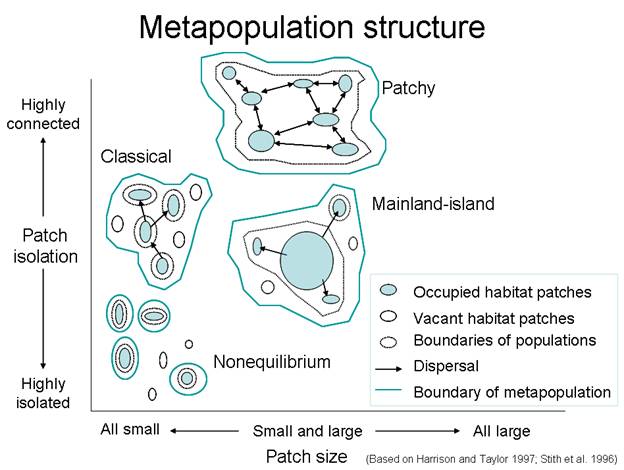WLF 448: Fish & Wildlife Population Ecology

Lab 11: Metapopulations
Fall 2010
I. Objectives of Lab
To learn about the metapopulation theory and models and how they relate to fish and wildlife populations.
-
Use a computer model based on metapopulation theory to become familiar with and understand how populations interact within a metapopulation.
II. Definitions
A. Metapopulation: set of local populations occupying various habitat patches and connected to one another by the movement of individuals among them (Ricklefs and Miller 2000) . Subdivided populations with demographically significant exchange among them (Gutierrez and Harrison 1996). A 'population of populations'. See definitions from Lecture.
B. Local population: Individuals of a species that live in a habitat patch. Sometimes used synonymously with subpopulation and population (Ricklefs and Miller 2000).
C. Habitat patch: Areas of habitat that require the resources and conditions for a population to persist (Ricklefs and Miller 2000).
D. Turnover event: When a habitat patch becomes unoccupied through extinction and is then recolonized by individuals from other local populations (Ricklefs and Miller 2000).
E. Metapopulation persistence time: Length of time all populations persist within a metapopulation until all go extinct (Ricklefs and Miller 2000).
F. Metapopulation structure: Describes the specific characteristics of natural metapopulations that are explicitly included in a metapopulation model. The intended result is to make the model more realistic. For example, the assumption that patches are all equally isolated could be made more realistic by specifying different migration rates among local populations. The types of modifications to the metapopulation model make the concept more useful (Ricklefs and Miller 2000).
G. Rescue effect: Migration between local populations prevents local extinctions (Gutierrez and Harrison 1996).
III. Types of metapopulation structures
A. Classical metapopulation model (i.e., Levins metapopulation model):
1. In this model, persistence requires an adequate rate of migration among patches (Harrison and Taylor 1997).
2. Small subpopulations within a metapopulation are extinction-prone but are sufficiently close to neighboring populations for recolonization to occur (Stith et al. 1996).
3. There are occupied and unoccupied patches within this metapopulation model.
B. Patchy metapopulation model:
1. All subpopulations are sufficiently close to function as a single subpopulation. That means that enough individuals are migrating between subpopulations that the subpopulations are not at risk of going extinct. Therefore the single subpopulation is acting as the metapopulation (Stith et al. 1996).
2. In this model, the subpopulations are not independent and their demographics are closely linked.
3. When a subpopulation goes extinct it is not noticed because it is part of a large continuous metapopulation, however if the single large subpopulation goes extinct so does the metapopulation.
C. Non-equilibrium metapopulation model:
1. Each subpopulation acts as a separate metapopulation (Stith et al. 1996). Each metapopulation is extinction-prone because of its isolation and small size.
2. In this model, the subpopulations are completely independent and their demographics are not linked.
3. The subpopulations are separated by large interpatch distances so that no migration occurs and when a subpopulation goes extinct it does not get recolonized (Stith et al. 1996). When extinction occurs the subpopulation and the metapopulation go extinct.
D. Mainland-island metapopulation model:
1. A system of patches or subpopulations located near a larger mainland patch or subpopulation. Dispersers from the mainland can reach each of the small patches or subpopulations (Ricklefs and Miller 2000).
2. It is assumed the mainland population does not go extinct (Ricklefs and Miller 2000). And if the mainland population does not go extinct neither does the metapopulation (Hanski and Simberloff 1997).

Selected references
Ricklefs, R. E., and G. L. Miller. 2000. Ecology. 4th edition. W. H. Freeman and company, New York, New York, USA.
Stith, B. M., J. W. Fitzpatrick, G. E. Woolfenden, and B. Pranty. 1996. Classification and conservation of metapopulations: A case study of the Florida scrub jay. Pages 187-215 in D. R. McCullough, editor. Metapopulations and wildlife conservation. Island Press, Washington, D.C., USA.
Gutierrez, R. J., and S. Harrison. 1996. Applying metapopulation theory to spotted owl management: a history and critique. Pages 167-185 in D. R. McCullough, editor. Metapopulations and wildlife conservation. Island Press, Washington, D.C., USA.
Levins, R. 1969. Some demographic and genetic consequences of environmental heterogeneity for biological control. Bulletin of the Entomological Society of America 15:237-240.
Levins, R. 1970. Extinction. Pages 75-107 in M. Gertenhaber, editor. Some mathematical problems in biology. American Mathematical Society, Providence, Rhode Island, USA.
Harrison, S., and A. D. Taylor. 1997. Empirical evidence for metapopulation dynamics. Pages 27-42 in I. A. Hanski and M. E. Gilpin, editors. Metapopulation biology: ecology, genetics, and evolution. Academic Press, San Diego, California, USA.
Hanski, I., and D. Simberloff. 1997. The metapopulation approach: its history, conceptual domain, and application to conservation. Pages 5-26 in I. A. Hanski and M. E. Gilpin, editors. Metapopulation biology: ecology, genetics, and evolution. Academic Press, San Diego, California, USA.
Revised: 15 November 2010